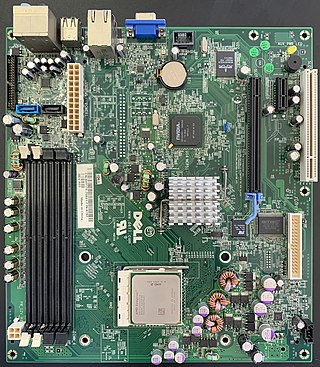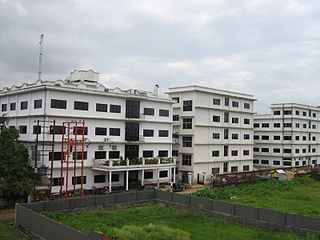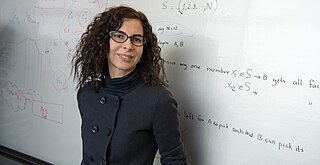Related Research Articles

Computer engineering is a branch of computer science and electronic engineering that integrates several fields of computer science and electronic engineering required to develop computer hardware and software. Computer engineering is referred to as computer science and engineering at some universities.

The New York University Tandon School of Engineering is the engineering and applied sciences school of New York University. Tandon is the second oldest private engineering and technology school in the United States.

Meghnad Saha Institute of Technology is a private college located in West Bengal, India. The college is located in the eastern suburb of the city at Nazirabad, Rajpur Sonarpur. The college is approved by the AICTE and the Directorate of Technical Education, and is affiliated with Maulana Abul Kalam Azad University of Technology.
The Advanced Learning and Research Institute (ALaRI), a faculty of informatics, was established in 1999 at the University of Lugano to promote research and education in embedded systems. The Faculty of Informatics within very few years has become one of the Switzerland major destinations for teaching and research, ranking third after the two Federal Institutes of Technology, Zurich and Lausanne.
A Hardware Trojan (HT) is a malicious modification of the circuitry of an integrated circuit. A hardware Trojan is completely characterized by its physical representation and its behavior. The payload of an HT is the entire activity that the Trojan executes when it is triggered. In general, Trojans try to bypass or disable the security fence of a system: for example, leaking confidential information by radio emission. HTs also could disable, damage or destroy the entire chip or components of it.
Hardware obfuscation is a technique by which the description or the structure of electronic hardware is modified to intentionally conceal its functionality, which makes it significantly more difficult to reverse-engineer. In other words, hardware obfuscation modifies the design in such a away that the resulting architecture becomes un-obvious to an adversary. Hardware Obfuscation can be of two types depending on the hardware platform targeted: (a) DSP Core Hardware Obfuscation - this type of obfuscation performs certain high level transformation on the data flow graph representation of DSP core to convert it into an unknown form that reflects an un-obvious architecture at RTL or gate level. This type of obfuscation is also called 'Structural Obfuscation'. Another type of DSP Core Obfuscation method is called 'Functional Obfuscation' - It uses a combination of AES and IP core locking blocks (ILBs) to lock the functionality of the DSP core using key-bits. Without application of correct key sequence, the DSP core produces either wrong output or no output at all (b) Combinational/Sequential Hardware Obfuscation - this type of obfuscation performs changes to the gate level structure of the circuit itself.
Robert W. Brodersen was a professor emeritus of electrical engineering, and a founder of the Berkeley Wireless Research Center (BWRC) at the University of California, Berkeley.

Farinaz Koushanfar is an Iranian-American computer scientist whose research concerns embedded systems, ad-hoc networks, and computer security. She is a professor and Henry Booker Faculty Scholar of Electrical and Computer Engineering at the University of California, San Diego.

Saraju Mohanty is an Indian-American professor of the Department of Computer Science and Engineering, and the director of the Smart Electronic Systems Laboratory, at the University of North Texas in Denton, Texas. Mohanty received a Glorious India Award – Rich and Famous NRIs of America in 2017 for his contributions to the discipline. Mohanty is a researcher in the areas of "smart electronics for smart cities/villages", "smart healthcare", "application-Specific things for efficient edge computing", and "methodologies for digital and mixed-signal hardware". He has made significant research contributions to security by design (SbD) for electronic systems, hardware-assisted security (HAS) and protection, high-level synthesis of digital signal processing (DSP) hardware, and mixed-signal integrated circuit computer-aided design and electronic design automation. Mohanty has been the editor-in-chief (EiC) of the IEEE Consumer Electronics Magazine during 2016-2021. He has held the Chair of the IEEE Computer Society's Technical Committee on Very Large Scale Integration during 2014-2018. He holds 4 US patents in the areas of his research, and has published 500 research articles and 5 books. He is ranked among top 2% faculty around the world in Computer Science and Engineering discipline as per the standardized citation metric adopted by the Public Library of Science Biology journal.
Theodore (Ted) Scott Rappaport is an American electrical engineer and the David Lee/Ernst Weber Professor of Electrical and Computer Engineering at New York University Tandon School of Engineering and founding director of NYU WIRELESS.
Vishwani D. Agrawal is the James J. Danaher Professor of Electrical and Computer Engineering at Auburn University. He has over four decades of industry and university experience, including working at Bell Labs, Murray Hill, NJ, Rutgers University, TRW and IIT, Delhi. He is well known as a cofounder and long-term mentor of the International Conference on VLSI Design held annually in India since 1985.
In cryptography, electromagnetic attacks are side-channel attacks performed by measuring the electromagnetic radiation emitted from a device and performing signal analysis on it. These attacks are a more specific type of what is sometimes referred to as Van Eck phreaking, with the intention to capture encryption keys. Electromagnetic attacks are typically non-invasive and passive, meaning that these attacks are able to be performed by observing the normal functioning of the target device without causing physical damage. However, an attacker may get a better signal with less noise by depackaging the chip and collecting the signal closer to the source. These attacks are successful against cryptographic implementations that perform different operations based on the data currently being processed, such as the square-and-multiply implementation of RSA. Different operations emit different amounts of radiation and an electromagnetic trace of encryption may show the exact operations being performed, allowing an attacker to retrieve full or partial private keys.
Optimization Systems Associates (OSA) was founded by John Bandler in 1983. OSA produced the first commercial implementation of space mapping optimization to enhance the speed and accuracy of engineering design. OSA’s primary thrust was in computer-aided design (CAD) and simulation and optimization of radio-frequency and microwave circuits and systems. Its products included developments of Bandler's space mapping concept and methodology, which facilitates effective modeling and design optimization of computationally intensive engineering systems.

David Atienza Alonso is a Spanish/Swiss scientist in the disciplines of computer and electrical engineering. His research focuses on hardware‐software co‐design and management for energy‐efficient and thermal-aware computing systems, always starting from a system‐level perspective to the actual electronic design. He is a full professor of electrical and computer engineering at the Swiss Federal Institute of Technology in Lausanne (EPFL) and the head of the Embedded Systems Laboratory (ESL). He is an IEEE Fellow (2016), and an ACM Fellow (2022).
Hardware security is a discipline originated from the cryptographic engineering and involves hardware design, access control, secure multi-party computation, secure key storage, ensuring code authenticity, measures to ensure that the supply chain that built the product is secure among other things.

Mark M. Tehranipoor is an Iranian American academic researcher specializing in hardware security and trust, electronics supply chain security, IoT security, and reliable and testable VLSI design. He is the Intel Charles E. Young Preeminence Endowed Professor in Cybersecurity at the University of Florida and serves as the Director of the Florida Institute for Cybersecurity Research. Since June 2022, he has served as the chair of the Department of Electrical and Computer Engineering at the University of Florida. He is a fellow of IEEE, ACM, and NAI as well as a Golden Core member of the IEEE. He is a co-founder of the International Symposium on Hardware Oriented Security and Trust (HOST). He is the recipient of the 2023 SRC Aristotle award. Tehranipoor also serves as a co-director of the Air Force Office of Scientific Research CYAN and MEST Centers of Excellence.
Lawrence Pileggi is the Coraluppi Head and Tanoto Professor of Electrical and Computer Engineering at Carnegie Mellon University. He is a specialist in the automation of integrated circuits, and developing software tools for the optimization of power grids. Pileggi's research has been cited thousands of times in engineering papers.
Krishnendu Chakrabarty is an Indian-American electrical and computer engineer. He is the Fulton Professor of Microelectronics at Arizona State University Ira A. Fulton Schools of Engineering. Before joining Arizona State, he was the John Cocke Distinguished Professor and was the Chair of the Department of Electrical and Computer Engineering at Duke University Pratt School of Engineering.
References
- 1 2 3 Jocelyn Silver (November 9, 2011). "NYU-Poly Team Develops Anti-Hacking Software" . Retrieved August 26, 2015.
- ↑ "Beyond Watson: NYU-poly researchers create smarter circuits". March 3, 2011. Retrieved August 26, 2015.
- 1 2 Thinh Tran (November 23, 2013). "WITH GRANTS, NYUAD PROFESSORS PURSUE RESEARCH" . Retrieved August 26, 2015.
- 1 2 3 4 "Ramesh Karri" . Retrieved August 26, 2015.
- ↑ Mike Lennon (November 8, 2011). "Students Develop Techniques to Keep Malware Out of the Electronics Supply Chain". Security Week. Retrieved August 26, 2015.
- ↑ "HOW TRUSTWORTHY IS YOUR DIGITAL HARDWARE?". November 10, 2011. Retrieved August 26, 2015.
- ↑ "NYU student cybersecurity researchers take honors at computer conferences". December 11, 2013. Retrieved August 26, 2015.
- ↑ "It's All IP In An SoC". June 5, 2014. Retrieved August 26, 2015.